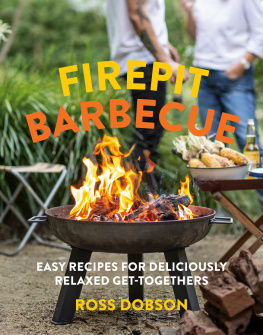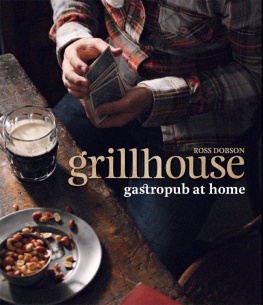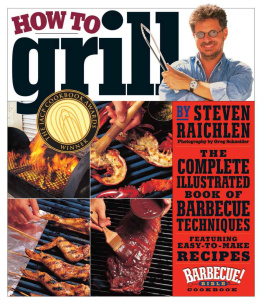FIRE UP THE FIREPIT
AND GET BARBECUING!
As an experienced chef and food writer and a dab hand with the barbie tongs Ross Dobson knows a thing or two about cooking with fire. In this book his recipes are especially tailored to creating great meals on a firepit with a simple grill or hotplate.
Ross shares tips on the best wood to use, foolproof instructions to tame the flame and make the heat last, advice on how to prepare food for the grill, marinades for tenderising and adding flavour, plus ideas for delicious butters, salsas, dips and breads.
Over 90 recipes, for chicken, fish, pork, beef, lamb, vegetarian meals and vegetables, are simple to prepare, fun to cook and perfect for your firepit barbecue Whether its fragrant chicken parcels for a healthy mid-week family dinner, whole trout with lemon and dill for Sunday lunch, or spicy beef kebabs for a cruisy Friday night feast with friends. Thats cooking with fire!
ROSS DOBSON IS THE AUTHOR OF MANY BEST-SELLING COOKBOOKS, INCLUDING FIRED UP, KING OF THE GRILL AND GRILLHOUSE (GASTROPUB AT HOME). ROSS USE OF INGREDIENTS AND COOKING TECHNIQUES DRAWS INFLUENCES FROM SOUTHEAST ASIA, THE MIDDLE EAST, INDIA AND THE AMERICAS. HE IS A KEEN OUTDOOR COOKER, BOTH ON THE BARBECUE AND, MORE RECENTLY, HIS FIREPIT. ROSS HAS ESTABLISHED AND OPERATED SEVERAL AWARD-WINNING CAFES AND RESTAURANTS IN SYDNEY.
FIREPIT COOKING
What is a firepit?
In the most basic sense, a firepit is just that: a pit of fire. What started as a simple hole in the ground, in which burning wood supplied heat for warmth and cooking, has become over the centuries more practical and safe through design. What many of us think of as a firepit is simply a vessel that burns wood, over which a suspended grill or hotplate can be fitted to cook food.
Ive seen the most basic of firepits nothing more than a recycled metal drum with holes punched in the side to supply air flow and enable the wood to burn (remember: a fire needs oxygen). A grill, such as an old cooking grill from an oven, is placed on top of the metal drum. Once the smoke and flames have subsided, it is ready to cook food over the heat emitted from the hot charcoal.
It is the heat from the charcoal that is required for cooking. You will notice that when wood is burning, its almost as if its alive: it hisses, spits and groans. These noises are made by the burning of the minerals and water in the wood, and the side effect of this is smoke. Smoke, and soot, is released while the volatiles in the wood are still burning away. And smoke is something you dont want when youre cooking on an open firepit. Cooking on a smoky fire gives an unpleasant diesel-like taste to the food. When the noise and smoke subsides, you are left with charcoal, which burns at a higher temperature than wood and should glow and pulse with heat. It will have few visible flames, releasing only pure heat. It takes time to achieve this, and patience is required.
Timber for your firepit
You might think wood is wood but there are many different types of trees. Soft timber from trees such as cypress, pine and fir burns too quickly and is no good for the firepit. These woods might be less expensive, but they wont go the distance. Do not burn treated timber from trees, and from other large plants that are toxic. Many of us may know that oleander, for example, is toxic, and shouldnt be burnt anywhere near people. The same goes for any treated or painted timber.
In Australia and New Zealand the best timber to burn is hardwood gum or eucalyptus. In Australia timber varies slightly from state to state. Generally speaking, the timbers that burn the longest are jarrah, iron bark, box and river red gum.
The same applies when choosing timber for burning in North America, the United Kingdom and Europe. Timber with the least pitch (resin) or sap is the best choice for burning on the firepit. In North America this is timber from maple, ash, birch and oak. The most widely available timbers for burning in the United Kingdom and Europe are similar to North America, but also include fruit trees with hard timber, such as cherry and apple.
The best wood for burning will feel dense, it should be grey in colour (definitely not green), hollow sounding when two logs are tapped together, and free of fibrous bark, or at least indications that bark can be broken away easily. What you are looking for is wood that is as dry as possible. Green wood, or wood with some bark attached, indicates there is moisture in the wood, which will produce more smoke and requires more energy to burn off the water and minerals. Worse still, it might not even burn at all. Always go for grey, dry and dense.
Preparing the firepit for cooking
Many modern firepits will come with an attachable grill, which is perfect for cooking. Remove the grill while you fire up the coals. Take two medium-sized pieces of firewood and place them in the centre of the firepit, parallel to each other and about 20 cm (8 inches) apart. Take two more similar-sized pieces of wood and place these on top, in the opposite direction, parallel and 20 cm (8 inches) apart. There will be a gap in the centre this is where you ignite the fire.
Crumple up some newspaper into loose balls and put these between the timber (egg cartons work a treat, too). Now arrange some kindling around the paper to look like a tee pee. Light the newspaper in several places, allowing it to catch and burn it wont take long before the kindling catches fire, but the large pieces of timber will need some more time. You can use a piece of cardboard or a baking tray to fan air into the fire and encourage it to burn.
Timber needs air and space to burn so dont overcrowd it. Give it time and space to turn into coals. It is not wood per se that you need to cook with; its what the wood becomes.
When is the firepit ready?
Over a period of about 2 hours, the timber becomes black and ultimately turns into charcoal. It will break up into small pieces and is supercharged with energy and glows with intense heat. Coals about the size of a golf ball, and no larger than a tennis ball, are what you are looking for to cook with. And, unlike wood, which needs space to burn, these hot coals work best when pushed together to generate and maintain optimum heat for cooking.
The easiest way to test if your firepit is ready for cooking is to trust your own senses. Firstly, use your eyes: you want to see small pieces of red-hot coals with a minimal amount of smoke. Secondly, use your sense of touch. Put the palm of your hand about 510 cm (24 inches) over the centre of the firepit. You should only be able to hold your hand there for some 23 seconds. Replace the grill over the firepit and give it around 10 minutes to heat up.














